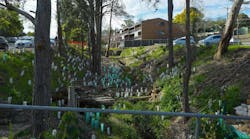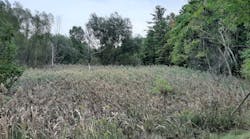Lee Brett is an environmental operations analyst with the Dallas/Fort Worth (DFW) International Airport, where he encounters numerous and unique erosion control challenges. DFW airport is surrounded by several cities, and some parts of the cities are inside the airport acreage. “As you go through DFW airport, you can actually go through five different cities,” Brett points out. “We have a lot of construction, and when we have storm events with water runoff, we have the possibility of pollution. All of that has the possibility of going to another city. We’re really careful not to send anything to somebody that they don’t want.” That includes constituents of concern common to airport settings: fuel, oil, and deicing chemicals. “We also have a tributary to the Trinity River that comes off the airport, so we have to be careful with the wildlife,” Brett adds. He continually focuses on federal, state, county, and municipal regulatory compliance. “It’s a lot of paperwork, phone calls, e-mails, and tons of meetings,” he says. “At the same time, I like to tell everyone my job isn’t in this office; it’s outside that door.” Looking ahead, Brett’s job shows no signs of slowing down. Of the airport’s nearly 18,000 acres, some 7,000 acres remain undeveloped and are home to wooded areas, deer, bobcats, coyotes, turkey, and beaver. “As we slowly go through that development, we have to watch the erosion,” says Brett. “The more trees you cut down and the more grass you get rid of, the greater the possibility of bad erosion.”
What He Does Day to Day
Brett wears many hats. “My primary concern is environmental construction inspection to ensure compliance with all federal, state, and local rules and regulations,” he says. “I also assist in the construction application review process, airport land-use management, SWPPP [stormwater pollution prevention plan] implementation, rain event sampling, winter weather deicing and stormwater monitoring, environmental site assessments, cross training, natural gas attainment, and 24-hour emergency response.” Brett brings 26 years of environmental experience in several different fields to the table and enjoys mentoring the employees just starting out on the proper way handling different environmental situations. In turn, he’s always learning something new.
“One of the biggest things I’ve learned about working here is the importance of the regulations,” he says. “I’ve never worked anywhere where we were so regulated.”
What Led Him to This Line of Work
Brett grew up on a farm and then spent several years programming computers. He decided being in an office all day was not for him. He originally entered the environmental field as a remediation technician, monitoring, repairing, and designing remotely controlled remediation systems. “Later on, I went to work for a company that had a contract with the DFW airport,” he says. “From there, I started overseeing construction projects as an environmental consultant. Eighteen years later, I’m still at DFW airport, I still like coming to work, and I am now a DFW employee. DFW airport is a great place to work. It’s challenging, and you never stop learning. I work with a great group of people who know a lot. I brought a lot with me when I came here, but I still learn from them. It’s something different every day.”
What He Likes Best About His Work
Brett says his line of work affords him the opportunity to learn new skills, meet new people, and work outdoors. “Construction at DFW never ends,” Brett points out. “Roadways, terminals, shops, restaurants, tenant warehouses, parking, airfield runways and taxiways, and light rail transportation all require environmental oversight during construction.”
His Biggest Challenge
Brett’s biggest challenge at DFW airport is keeping up with all of the changes and ongoing new construction. “DFW airport never sits still or stops evolving,” he says. “I have never gotten bored working here. Sometimes the workload is overwhelming, but I always seem to make it through.” The strategic vision of DFW International Airport is to “Connect the World,” and along with that, the airport is experiencing significant growth with the airlines and commercial development, he says. “It’s always challenging to balance our goal of being environmental stewards with such a diverse and active operating facility.”


